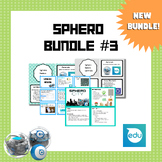*NEW* Sphero City Builder: Learn Robotics and Programming Through City Design
- PDF
Also included in
- New Bundle featuring SPHERO CITY!!!This bundle includesSphero Basics: MovementSphero Basics: ControlsSphero City *NEW*Sphero Review Game for ANY contentPrice $16.00Original Price $19.98Save $3.98
Description
Sphero City Builder: Learn Robotics and Programming Through City Design
Looking for a fun and engaging way to introduce your students to the world of robotics and programming? Look no further than this comprehensive resource pack! With Sphero City Builder, your students will learn how to build a city and program a Sphero robotics ball to travel down the roads they create.
This pack includes:
- Step-by-step instructions for building a miniature city using simple materials
- Tips for creating a functional road system that can accommodate the Sphero ball
- Lessons on programming the Sphero ball to travel down the roads using block-based coding
- Printable materials to help students plan and design their cities
- Teacher's guide with tips for implementation and differentiation
Whether you're teaching STEM concepts, robotics, or programming, this pack has you covered. With engaging activities that challenge and inspire your students, they'll be on their way to becoming robotics and programming experts in no time.
Don't miss out on this opportunity to help your students build real-world skills while having fun - grab Sphero City Builder today!




